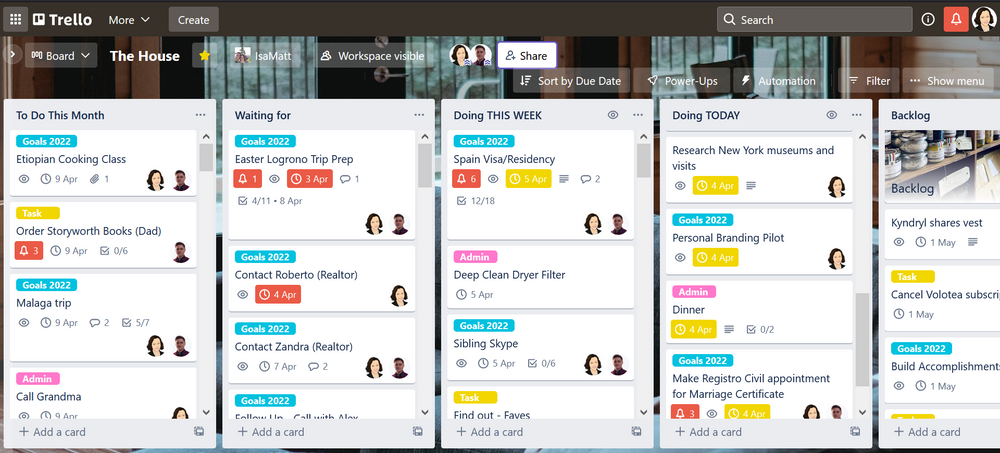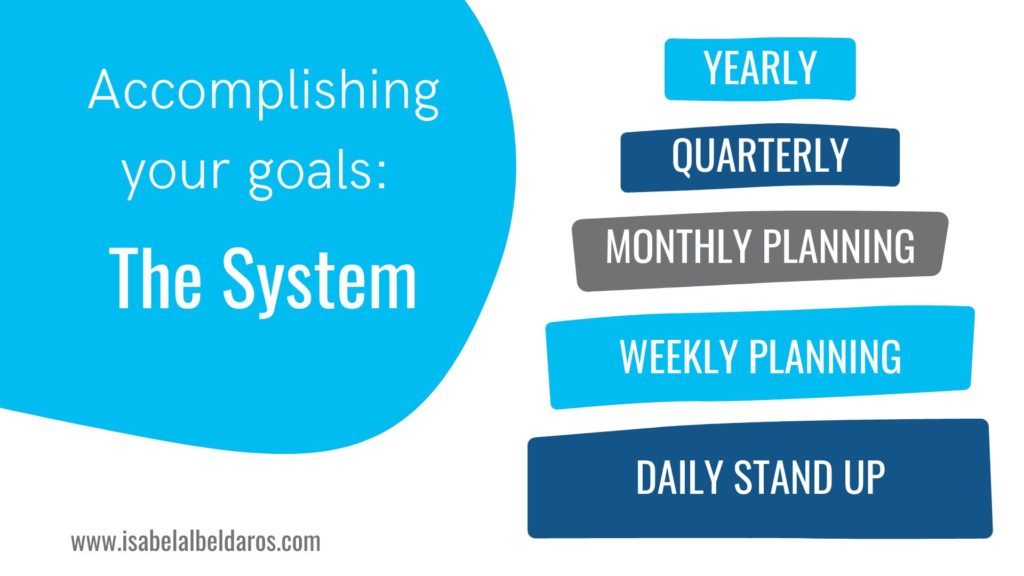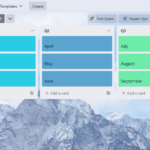This article is part of my Systems for Success trilogy:
- How to look back over your year (without getting lost in it)
- How to Set Goals for the New Year (and take your resolutions past January)
- The magic system I use to follow through on my goals: How to accomplish all your goals (and 10x your productivity this year)
How are your New Years goals looking? If you feel like your days are packed, you’re always busy, and you’re making little-to-no progress, what you need is a system that takes you from to-do list to building your year (and your life) with purpose. A year sounds like plenty of time, but when you start breaking it into months (and adding in other commitments, like holidays, family time and the like), twelve months just seems too short.
So if your goals quickly get pushed to the side, and you’ve started worrying about how you’re going to accomplish them (or you just want a more efficient way of managing your life) then read on. I have the solution.
I’ve been using some version of this system for years, but the iteration I’m sharing below is the one I used in 2022 and it was my most productive year to date, both in terms of goals (moving countries included!) and in terms of fun, friends and family time. Proper systems make your life a lot easier!
So what does it look like? While I try to keep it simple, I borrow pieces from project planning, agile methodologies, time blocking and productivity methods, coaching and of course from years of experience.
The Tools I Use
My main tools are Google Calendar and Trello. Both are free to use and I’ve found them to have the best mix of features to help me keep on top of everything. But you can use any tools that provide a calendar and a to-do list.
Here’s why I recommend these two tools:
Trello
The benefit of using Trello is that it lets you 1) automate a lot of work (you can check out my automation guide for Trello here) and 2) share in real time with other people (in my case, my husband). It also makes it easy to drag and drop, change due dates, and add information, such as checklists, comments or links. You can use it on your phone, tablet or computer and it quickly syncs across devices.
I keep two main boards on Trello, one for Goals (as shown in How to Set Goals for the New Year (and take your resolutions past January)) and one for the daily running of the household / tasks, which I call The House. I use the Goals board for making sure I’m keeping on top of my goals, habits and other objectives, and The House for everyday management of what needs to be done. This set-up works for me because it gives me a place to track goals without cluttering up my everyday to-do list.

Google Calendar
The benefit of using an online calendar is that you’re quickly able to reorganize and reschedule if needed, you can set alarms and you’re able to quickly access the latest version as long as you have access to the internet. It’s great for sharing with a partner as well, and helps you easily track your time since it’s quick and easy to edit. Google Calendar worked best for me because it integrates with other tools and systems I was already using, but if you’d rather go with a different calendar that you’re already using don’t worry, the system will work just the same with another online calendar. If you prefer to stick to paper, just be aware that editing existing entries is going to be a bit harder for you.
I keep a shared calendar with my husband, to make communication easier. You can also set up a family calendar to clearly see all your family commitments, a work calendar to view your work commitments, etc.
The Principles
There are 6 key principles that drive my system:
- Purpose – organization, introspection and planning is how we move from trudging along going wherever life leads us to living with intent, meaningfully pursuing our goals, and building a life that truly works for us. Purposeful, mindful choice is at the center of my system and permeates it throughout. You’ll be making decisions on what you prioritize, how you spend your time, which goals you pursue, and how – every facet of your life included.
- Planning – planning lets you break things into manageable increments (i.e. the difference between having “find a job” in your to-do list, and having “update CV”, “update LinkedIn”, “apply to 5 roles”, etc.). It makes it easier to accomplish a goal – instead of being faced with overwhelm when tackling a new goal, and having to figure out what you’re going to do to move it forward every time you address it, you have a roadmap ready. In the planning stage is where I size the goal, to understand the time commitment it represents and make sure I’m not overcommitting myself.
- Time Blocking – essentially, time-blocking refers to breaking your day into blocks of time, each dedicated to a specific task or group of tasks. Using a time blocking approach means that I know in advance what I’m going to be working on – I don’t waste time and effort figuring out which item I’m going to tackle whenever I go work on my goals, my calendar already knows. If you tend to pile too much on your plate, time blocking can be a godsend, since there’s only so many hours in the day – when you break down your plans and check them against your calendar it shows you what is achievable and what would require you to pull all-nighters for a month to accomplish. Blocking off time in your calendar for goals makes it harder to overload yourself.
- Flexibility – Planning and time blocking can become unmanageable and stressful without a little flexibility, and that’s the last thing we want! The whole point is to make our lives easier, not harder. So understanding a little flexibility will be necessary, adjusting plans and schedules (and sometimes even goals) as needed is key. One way I build in flexibility in my calendar is to include “Task Catch Up” slots, with the purpose of catching up on work that has taken longer than expected, having a slot to move overflow to, or to catch up on the little tasks that crop up in between planning sessions. I try to have at least two of these per week, three if you’re just starting out with planning and aren’t sure your time estimates for work are very accurate yet.
- Purposeful Rest – I make sure to include time for resting when I plan (without guilt or shame; borrowed from clean rest, a key concept in Power Planning). Without rest you’re burning the candle at both ends, and not only do you risk burn out, the quality of the work you do get done will also be compromised. So give yourself time to rest, relax and recover; build it in. I like to prioritize high-quality leisure – that is, the kind of thing I would say yes to if you asked me on Monday morning and not only if you asked me after a long day of work. Boardgames, self-care, reading, painting, watching a movie, going for a walk on the chill side of the spectrum, and things like theatre shows on the more elaborate end. That’s not to say mindless scrolling has no place in purposeful rest, but it won’t make up the bulk of it, which is my default otherwise.
- Automation – this is the main reason I use the tools that I do – they let me automate a lot of the work, making time for me to focus on getting things done instead of maintaining systems; they should be working for you, not the other way around. You can read about my automation (and how you can apply it) at length here, but just to give you a taste – my Trello helps me see what’s due today, this week and this month, and automatically updates it as I go; it also creates reminders for me to buy birthday gifts, do house maintenance, and a myriad other things. Automation comes into my life in other ways as well – for example, when I was struggling to meet my bedtime habit goal, I used a smart plug (under £15) to make the lights turn off as a bedtime warning. Whatever can be automated, will.
How it works
Principles and tools are all good and well, but how does it actually work? Well, once you have your goals set (How to Set Goals for the New Year (and take your resolutions past January)), this is how you manage them:

Quarterly Planning
Once a quarter (usually March, June, September and December) I do a quarterly review session, which takes approximately 60 minutes. I review my calendar and Goals Trello board, to make sure I’m fresh on what’s happened over the last three months. Another option is to look at your monthly reviews for the quarter.
These are the questions I use to guide the quarterly retrospective:
(Throughout this post, I provide both the “single” version of the questions, useful if you’re planning solo, and the “couples” version, useful if you’re planning with a partner. You can also tweak some of these to include others, such an accountability partner, your kids, etc.)
Review the previous quarter. Calendar and Trello goals board can be useful to guide this.
What themes emerged this past quarter?
What worked?
What didn’t work? Where did I make mistakes or fall short?
What did I learn?
How can I apply what I learned in the next quarter?
What were the big moments, memories, and milestones from this quarter?
And the most important goal(s) I achieved?
What inspired/excited me? Think people, places, habits, tasks, experiences
How can I do more of those next quarter?
What were the lowest point(s)?
What can I do to reduce those next quarter?
What’s the single biggest bottleneck to my continued growth?
How can I tackle it?
What new skills did I learn? / How did I grow this quarter?
What am I most grateful for this quarter?
Review ‘Wheel of life’ – what are my scores for this quarter?
Review the previous quarter. Calendar and Trello goals board can be useful to guide this.
What themes emerged this past quarter?
What worked?
What didn’t work? Where did we make mistakes or fall short?
What did we learn?
How can we apply what we learned in the next quarter?
What were the big moments, memories, and milestones from this quarter?
And the most important goal(s) we achieved?
What inspired/excited us? Think people, places, habits, tasks, experiences
How can we do more of those next quarter?
What were the lowest point(s)?
What can we do to reduce those next quarter?
What’s the single biggest bottleneck to our continued growth?
How can we tackle it?
What new skills did we learn? / How did we grow this quarter?
What are we most grateful for this quarter?
Review ‘Chore Audit’ – are we still happy with the chores distribution?
Review ‘Wheel of life’ – what are our scores for this quarter?
Once you’ve completed the quarterly retrospective, it’s time to prep the coming next quarter. Start by reviewing the goals you have for the quarter. They should be sized as small, medium and large scale. Decide how you’re going to split them among the three coming months – some may start in month 1 and continue until month 3, some will be smaller and more localized – and align them to the first month you need to be working on them. Is there enough time to accomplish everything you currently have aligned to each month? Make sure to review your calendar so things like holidays, family commitments, etc. don’t trip you up later. Do you need to re-prioritise or change things? Does something need to shift in your plan based on new information and circumstances?
Once you’re happy with the monthly distribution of goals, I recommend copying them over to your task board with the appropriate deadlines. And then it’s time for monthly planning.
Monthly Planning
At the start of each month I set aside 60-90 minutes for my monthly planning. I start with a review of the past month, quickly going over my calendar and reviewing and updating each of my habits and goals for the month. For long term habits I like to assign a monthly score, from 1-10 to track progress, and goals will either be moved to the Done column if complete or moved to the next deadline if appropriate.
These are the questions that help me reflect on the month:
From 0–10, how do I feel I’m doing?
What were the highlights (memories, accomplishments, big moments, etc.)? I.e. what made me feel proud, happy, fulfilled, grateful? What things brought me the most energy and joy?
What were the lowlights? i.e. what was hard on me, drained my energy or took a negative turn (people, habits, tasks, etc.)?
What were the biggest lessons learned?
What am I most grateful for?
What themes emerged this past month?
What’s on my “best of” list this month? (books, events, articles, podcasts, purchases, new habits)
How did I grow as a person? (New skills, habits, priorities, preferences, relationships, perspectives, environments…)
Is there a difficult conversation(s) I’m currently avoiding (with both myself and others)?
What’s something I’ve been dreaming about lately for my future?
Did I spend my time on the right things?
If not, how will I improve next month?
From 0–10, how do we feel we’re doing?
What were the highlights (memories, accomplishments, big moments, etc.)? I.e. what made us feel proud, happy, fulfilled, grateful? what things brought us the most energy and joy?
What were the lowlights? i.e. what was hard on us, drained our energy or took a negative turn (people, habits, tasks, etc.)?
What were the biggest lessons learned?
What are we most grateful for?
What themes emerged this past month?
What’s on our “best of” list this month? (books, events, articles, podcasts, purchases, new habits)
How did we grow as a person? (New skills, habits, priorities, preferences, relationships, perspectives, environments…)
Is there a difficult conversation(s) you’re currently avoiding (with both yourself and others)?
What’s something you’ve been dreaming about lately for our future?
Did we spend our time on the right things?
If not, how will we improve next month?
Once the review is complete, it’s time to plan for the upcoming month. Look at your goals for the month, now that you’ve moved any uncompleted ones in from the past month. Is there enough time to accomplish everything you currently have aligned to this month? Make sure to review your calendar so things like holidays, family commitments, etc. don’t trip you up later. Do you need to re-prioritise or change things? Make sure your goals are reflected in the task board – you can take two approaches here, to have several items per goal (i.e. “update CV”, “update LinkedIn”, “reach out to 5 recruiters”, “apply to Job X” as individual cards or tasks) or to have a single one with a checklist (i.e. one card called “Find new job” with a checklist detailing those items). I prefer the former, since it gives me more control and using trello I can relate each of the task cards to the right goal, but do whatever feels more comfortable for you. For big items coming up this month (i.e. trips, all-day events, etc.) I try to schedule them into the calendar at this point, especially since they usually require some advance notice.
And then it’s time for weekly planning – you don’t want to get too granular in your monthly planning, or you risk ending up with a fairly rigid schedule for the month that doesn’t give you the flexibility you need. Unless there are items that need to happen at specific points in the month, weekly planning is your best bet for popping them in the calendar.
Weekly Planning
Set aside some time every week for planning the week ahead. I like to reserve 30-60 minutes every Friday, since that’s when I’m least productive otherwise, and I plan my week Saturday to Friday, but find a slot that works for you. Having the same slot every week helps build the habit, so if you can, keep it consistent.
I start with a review of the past week – usually with a quick flick through the calendar, and (if needed) I update the calendar to reflect what I actually did. I try to do that as I go, but it’s good to catch any changes I’ve missed.
These are the questions I use for my review, to help me reflect:
How did last week go?
What’s the biggest challenge I’ve faced this week (work/marriage/other)?
What am I most proud of this week?
What’s one thing I’m afraid of right now?
What’s one thing I’m really excited about right now?
Did anything emerge that I need reflect on?
How did last week go?
What’s the biggest challenge we’ve faced this week (work/marriage/other)?
What are you most proud of this week?
What’s one thing you’re afraid of right now?
What’s one thing you’re really excited about right now?
Share something that you’ve noticed about each other this week – something that inspired you, you’re proud of, or grateful that the other person did.
Did anything emerge that we need to discuss?
Once I’ve completed the above, I go over the habits in my goals board, just to see how I’m doing and whether I need to change something that hasn’t been working this week.
Then I look at the week ahead, checking both the goals and the tasks in my Task Board, and populate my calendar with the necessary time blocks, including clean rest, tasks catch ups and being mindful of other commitments. Time blocks are most effective when you’re specific regarding the task or objective to accomplish (i.e. “identify top two options for catering” versus “working on wedding”). If any goals have been completed, then I move them to the done column of my goals board.
These questions can also be helpful when planning the next week:
Are there any goals/tasks where I need assistance? How can I get it?
If I do nothing else this week, what is the one thing I should be sure to focus on or accomplish?
What’s one thing I can do for you this week?
If we do nothing else as a family this week, what is the one thing you think we should be sure we focus on or accomplish?
At the end of the weekly planning session you should have a good idea of what worked and what didn’t the previous week, what your focus item is for the coming week, and how you will be spending your time.
Daily Stand-Ups
To make sure I’m on top of my plan for the day, and to adjust if needed, I do one daily stand-up. Borrowed from agile management, technically a daily stand-up is a short, daily meeting to discuss progress and identify blockers; I typically do this with my husband but you can do it by yourself as well. We quickly review what we’re planning to do today, make sure we’re still good for it and do a quick replan if needed.
Why it works
The system may seem a bit overwhelming when seeing it all on a page, but once you set it up (which you can do in a weekend) it takes very little time and effort to keep it running, and you’ll find when you’re being purposeful about it you actually have more time than you did before.
It keeps you focused on your priorities, reminds you to reflect and make conscious decisions, reduces friction when working on your goals, and keeps you from overloading yourself.
Give it a try. Maybe just commit to a quarter and see how it goes. You won’t be disappointed!
And of course, tweak it, keep and discard as you will – iteration is what makes any system great.
Your turn: Get set up
If you’re ready, here’s how you can get set up:
- If you don’t have a trello account, simply click here to sign up.
- Swipe my task board – the template is available here, just click on it and copy the board to your workspace.
- Swipe my goals board – the template is available here, just click on it and copy the board to your workspace.
- To set your goals, check out Setting Personal and Professional Goals for the New Year.
- Learn more about how to automate your trello in Trello Automations to make your life easier – and make time for the things that matter.
Make this your most productive year yet. And let me know how it goes in the comments below!




No comment yet, add your voice below!